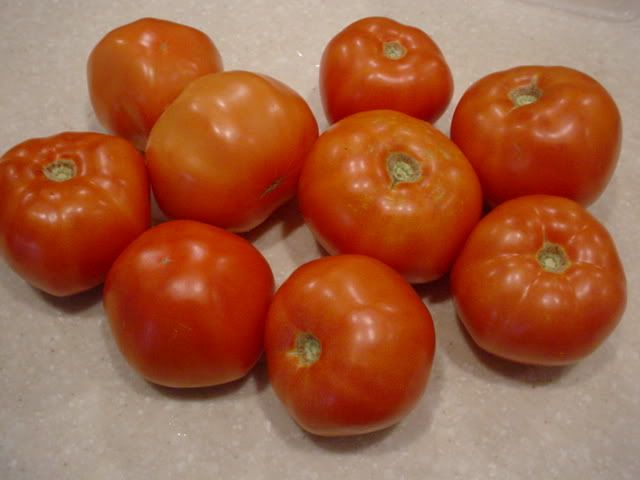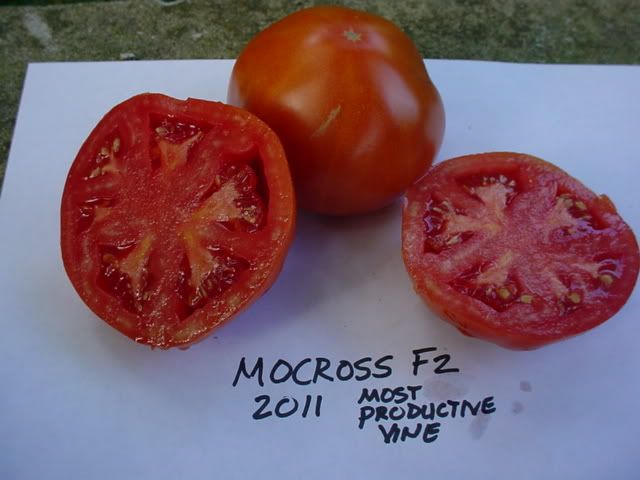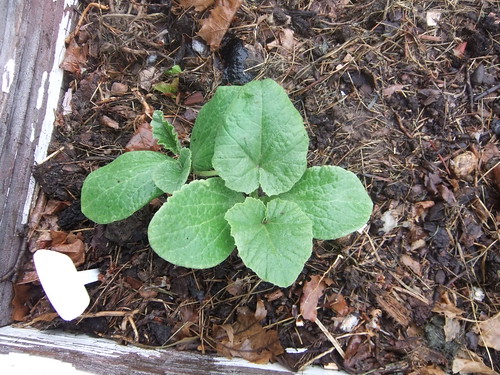|
|
Post by oxbowfarm on Feb 16, 2012 7:19:22 GMT -5
I was really interested in the "Any OP heart cherry tomato?" thread by PapaVic's formula for progeny size in F1 crosses. The F1 fruit will be sized approximately at the square root of Size A x Size B. In other words, when you cross say Green Giant (a 12 - 14 ounce beefsteak) x Yellow Submarine (a pear shaped cherry same size as Yellow Pear), you will get at most, a ping pong size cocktail/saladette tomato: + Forgot to say earlier that fewer locules as in cherry tomatoes are dominant over multi-fasciated seed locules as in beefsteak tomatoes. Is there a generally accepted formula for earliness? Say if you cross a 60 day tomato with an 80 day, where does the F1 fall in? In general it seems like the smaller tomatoes are earlier than larger fruited ones, so if size drags towards the smaller parent then would earliness? I'm actually very interested in creating some "personal tomato hybrids" for our hoophouse production. The hybrids I have been using have a lot of stuff that I don't particularly need like disease resistances to southern soilbourne pathogens and firmer fruit than is strictly necessary in my situation. I'd like to work trialing some crosses that would give me a nice TASTY red slicer in the 6-8 ounce range with a lot of hybrid vigor coming in at around 68 to 70 days. Basically a replacement for Big Beef with less firmness and better flavor, although Big Beef is quite acceptable already to my customers. Any thoughts? Some of this is for practical purposes and some of this is just super fun to me. This is the kind of thing I find totally energizing. |
|
|
|
Post by keen101 (Biolumo / Andrew B.) on Feb 16, 2012 10:08:30 GMT -5
|
|
|
|
Post by PapaVic on Feb 16, 2012 12:35:42 GMT -5
Oxbow, the same fellow who gave me the "formula" for F1 size trending to the smaller parent also told me that a hybrid tends to be earlier than A + B / 2. In some cases, I think the hybrid is earlier than either parent, rather than simply earlier than the average between the two. As an example, I offer my experience with Mozark x Sioux. I made this cross to replicate MoCross Surprise (aka Missouri Surprise), a hybrid product long ago discontinued by University of Missouri, along with Avalanche (Mozark x Glamour), both of which were very popular in Arkansas and Missouri. Anyway, Mozark tends to run 80 days from transplant, while Sioux runs about 75 days from transplant. My F1 cross came in 68 - 72 days from transplant under the same conditions, and I had three F2 vines that were the second earliest full size tomatoes in the garden in 2011, with only Neptune running ahead. The MoCross replicas have consistently been baseball size when grown under proper conditions, have set fruit at up to 82*F nighttime temps (and up to 98*F daytime), are not as hard as Big Beef, very well flavored, and crack resistant (I only grow outside, and always in hot, humid, typically Midwestern wet conditions). Here are some Mozark x Sioux (F2) grown under milder conditions, showing no cracking.  Here is a photo of the worst fruit of the summer due to very hot weather followed by heavy rain.  Here you can see the worst condition experienced all summer - some puffiness due to hot, dry weather.  |
|
|
|
Post by PapaVic on Feb 16, 2012 12:41:31 GMT -5
I don't know where you grow tomatoes, Oxbow, and I have no idea what your weather and disease pressures are.
If I might ask a few questions: Are you looking mainly for determinate or long vine tomatoes for your hoop houses? And what disease resistances do you need in a hoop house tomato? I assume you're looking for heat tolerance, and you already have indicated round and red fruit.
|
|
|
|
Post by oxbowfarm on Feb 16, 2012 13:01:17 GMT -5
We are located in the "Southern Tier" of New York in Chemung County. Our farm is at the bottom of a valley that flows into the Chemung River so we are in a pretty bad frost pocket. For that reason and due to the seemingly perennial late blight that has been occurring the last few years, I have switched to only growing indeterminates inside the hoophouse. For hoophouse growing most of the literature recommends using commercial greenhouse hybrids even though they aren't actually bred for hoophouse conditions.
One major difference in my production technique is that I'm using mobile hoophouses, this enables me to rotate off a piece of ground and avoid the kind of disease and pest build-up issues normal to greenhouse production. I have very little to no soil-bourne disease, the houses are relatively small and have roll-up sides so I have not had problems with foliar disease thus far. Its proven to be a better system for me vs outdoor production. Plus I enjoy it, it is fun to be in them among the tomatoes. We are doing the standard single leader indeterminate pruning system for greenhouse tomatoes with synthetic twine and clips.
I've been using primarily New Girl and Big Beef and they work pretty well. But I'd like to get away from Seminis/Monsanto products as much as possible and I'm not interested in messing with grafting. I find it tedious and the benefits don't mesh with my production system. I don't have soil pathogens for the most part, why spend $0.50 a seed for resistant rootstock seed when a hybrid will give me enough vigor? But the commercial hybrids are not really well matched to my system either, this is why I am interested in breeding my own. Plus it just seems like a kick-in-the-pants. I REALLY like the A + B / 2 formula, that is way better than I was expecting.
Do you find that flavor is inferior in an F1 vs a more stabilized OP? I notice you had MoCross F2s? Are you aiming to stabilize the MoCross or continue to cross the parents to get your MoCross when you want it?
|
|
|
|
Post by PapaVic on Feb 16, 2012 16:59:34 GMT -5
Oxbow, the MoCross is not stable yet, as you can imagine. Mozark is determinate, and I've seen Sioux described alternately as indeterminate and semi-indeterminate.
Of the three F2 vines I grew in 2011, one was determinate, but not as productive as I would've liked, one was semi-determinate and very suitable to my outdoor uses, and the 3rd one grew and yielded all season like an indeterminate does, but put out inflorescences (flower clusters) every second internode rather than every third internode as a fully indeterminate would.
Also, sometimes on both the "semi-determinate" and the "semi-indeterminate," the flower clusters would appear directly opposite the leaf nodes, so in those cases the internode spacing for the inflorescences actually was "1.5" (one full internode space + 1/2 a space) rather than emerging in the middle of the 2nd internode. This pleased me because the fruit yield was 2 to 4 fruit set per cluster.
As to what I intend, since this is a hobby for me, some of what I do is just entertainment. But some of what I do is serious in the sense that I am trying to develop heat tolerant lines with disease resistances addressing lower Midwestern, Southern, and semi-tropical conditions. To that end, I also am crossing Neptune (bacterial wilt resistant) and another bacterial wilt/bacterial spot resistant line (don't want to name it publicly) into the Mozark x Sioux F2s. This will result also in my selecting for more determinate lines.
I want determinate lines because I am sending seed to the Caribbean where tradewinds play hell with indeterminate plants outdoors. They need them short to grow sprawled or tied up to short stakes. That's why I asked you whether you preferred determinates or long vines in your hoop houses. I got both right now, but will be moving more in the direction of determinate with these MoCross x Neptune things.
I got some other stuff too where we are crossing heirloom types with modern indeterminate disease resistant types, and you may be more interested in those. The idea there is to get a higher yield of sound fruit on a more durable vine but incorporate better, old fashioned flavor. The one that appears the most stable for its various expressions at this time has only about 3 - 5 ounce, pink fruit in clusters of 4. I don't know if that interests you.
|
|
|
|
Post by oxbowfarm on Jun 26, 2012 7:39:18 GMT -5
Well, we've started goofing around with tomato crossing, thought I'd update this thread. The first attempt was sort of a trial run but it took! I'd been planning on using a potato leaved variety in some of the crosses as a mother because the F1 seedlings should immediately show if the cross was successful if they turned up regular leaf. Or at least that some kind of cross had occurred. This first one was Brandywine Pink X Matt's Wild Cherry. I didn't start the Brandywine plant, I bought it from another vendor at the market. He said he got the seed either from High Mowing or Fedco so I assume it is some strain or other of Brandywine Sudduth. I was intruiged by the idea of an F1 cherry from a beefsteak, and Matt's Wild is a really small cherry so it should drag the size down pretty close to a large cherry or small salad tom.  |
|
|
|
Post by Darth Slater on Jun 26, 2012 8:11:43 GMT -5
You can get Papvics crosses at Mariseeds, he has his own page and alot offered on it are early producers..you have the option of selecting your own early tomato out of the progeny.
Since we added this page, the response is VERY positive!!
|
|
|
|
Post by raymondo on Jun 29, 2012 18:34:23 GMT -5
Galina's Yellow, a PL yellow cherry, makes a good seed parent. Very easy to emasculate and effect the cross and there's a good number of seeds per fruit. Try it with Kellogg's Breakfast as pollen parent. You should get a red F1. I did a similar, though slightly more complex cross and got a superb small red but one parent was a segregating cross so it's not repeatable. Mine was (Galina's x Snow White F2) x KBX
|
|
|
|
Post by oxbowfarm on Jun 29, 2012 19:30:24 GMT -5
I've been emasculating a lot of flowers lately. Bloody Butcher is a bloody bitch. The flowers are microscopic and wicked brittle. I've pretty much given up using them as anything but a pollen parent. I think you could get away with it on the very first trusses, my memory of them was that they were bigger and more robust. Very easy to emasculate are Eva Purple Ball, Neve's Azorean Red, Gregori's Altai, and Ohio Crack Resistant.
|
|
|
|
Post by nathan125 on Jun 30, 2012 1:34:12 GMT -5
Cold set tomato is allegedly renowned for it's ability to germinate in very cold soils. perhaps there is some merit to it. i plan on giving it a try next season
|
|
|
|
Post by keen101 (Biolumo / Andrew B.) on Feb 7, 2016 23:27:02 GMT -5
Cold set tomato is allegedly renowned for it's ability to germinate in very cold soils. perhaps there is some merit to it. i plan on giving it a try next season Any update to this? |
|









